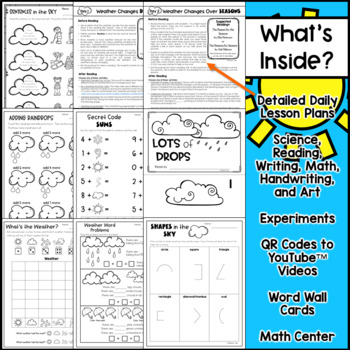Weather Unit for Kindergarten and First Grade
- PDF
What educators are saying
Description
The forecast calls for lots of fun and learning with this weather unit for kindergarten and first grade! The week-long comprehensive unit includes detailed daily lesson plans with literature suggestions. It incorporates science, reading, writing, math, experiments, handwriting, and art. It also includes QR codes and links to videos that complement the unit study.
Click on the PREVIEW to read each lesson plan, see the Week-at-a-Glance planning sheet, as well as examples of printables and art projects.
Teacher Features You’ll Love
- Detailed daily lesson plans
- Week-at-a-glance planning guide
- Guide for stretching the unit over two weeks
- Key concepts and objectives
- Extensive literature lists of fiction and nonfiction books
- Video links and QR codes
- Differentiated versions of math sheets
- Activity directions and printable templates
What’s Covered in the Unit?
Day 1: Weather Changes Day to Day
- Weather watching activity
- Weather Words booklet
Day 2: Weather Changes Over Seasons
- Model seasons
- Celebrate the season activity
- Weather watching- seasons
Day 3: Clouds
- Cloud types chart
- Cloud in a jar experiment
- Cloud art
Day 4: Precipitation
- Examples of precipitation videos
- Make a rain gauge
- Blow painting rain art
Day 5: Wind
- How wind affects us
- Make a weather vane
- Make a windsock
Math Connections
- Counting raindrops math center
- Adding and subtracting raindrops math center
- Counting within 10, 20, and 100
- Counting groups of 10
- Comparing numbers within 10, 20, and 100 (with and without >, <, and = signs)
- Addition and subtraction within 10, 20 and 100 (no regrouping)
- Place value: tens and ones
- Making 10
- Drawing 2D shapes
- Making composite drawings from 2D shapes
- Graphing
- Time to the hour and half hour
- Measuring with nonstandard units
- Compare lengths/heights of two objects
- Word problems
Literacy Connections
- Weather word wall
- “Lots of Drops” emergent reader (includes digital Google Slides version)
- Letter recognition
- Beginning, medial, and ending letter sounds
- Beginning cl- blend
- -ain family words
- Making words with the letters in weather
- CVC words
- Fluency
- Beginning comprehension
- Beginning, middle and end- beginning story writing
- Correct a mixed-up sentence
- Seasons writing prompt
- The Big, Bad Storm writing prompt
- Down Came the Rain writing prompt
- Whatever the Weather writing prompt
- Clouds Acrostic Poem writing prompt
Questions? Feel free to email me at primarythemepark@gmail.com or contact me through the "Product Q & A" tab here.
You might also like:
Thanks so much for stopping by!





